So, I don't know how many people regularly read my blog, but those who do may have noticed that I haven't been posting much lately. That's because I've been having less and less time for school. My business is taking up a lot more time. Instead of doing surface design for an hour every other day, I now have to do it for a few hours every day. Now, according to the unschooling method, this is still school because I am learning things about surface design as I do it professionally, such as how to replicate a color I mixed in a previous batch, how to make new colors, and how to make items thick enough to be serviceable while using a fabric that's thin enough not to be a pain. I am currently working on a batch of napkins and placemats for my brother and sister-in-law, who have requested green and brown for the placemats and yellow and blue for the napkins. Additionally, they want something natural-looking. I have made mistakes and had to start again, run out of supplies, and all kinds of adventures. Also, I'm trying to focus a little more on the business side of things, such as picking up supplies, communicating with future clients about exactly what they want, recording expenses, and arranging deliveries.
Here are some photos of the project, part of the way through:

Pole-wrapped napkins with glue resist drying. The mess you see around them is the typical state of my studio. I can clean it up (clean is a relative term) and it will be this messy again in an hour and a half.
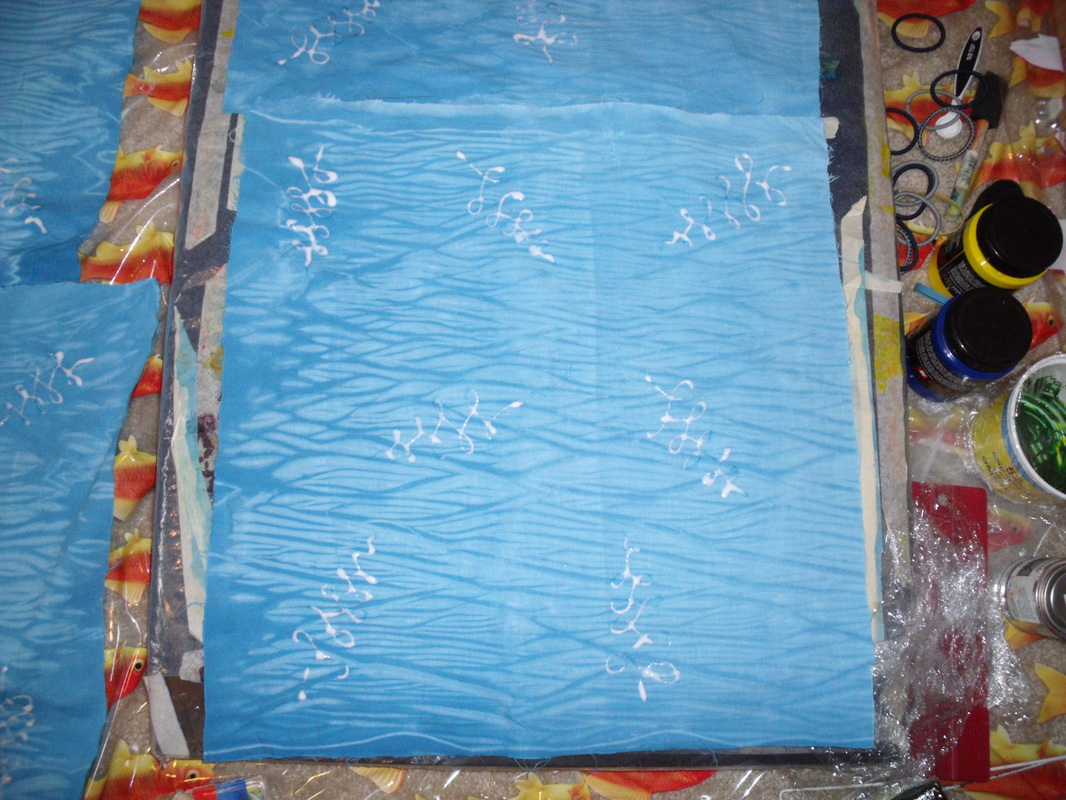
Close-up of the glue resist.
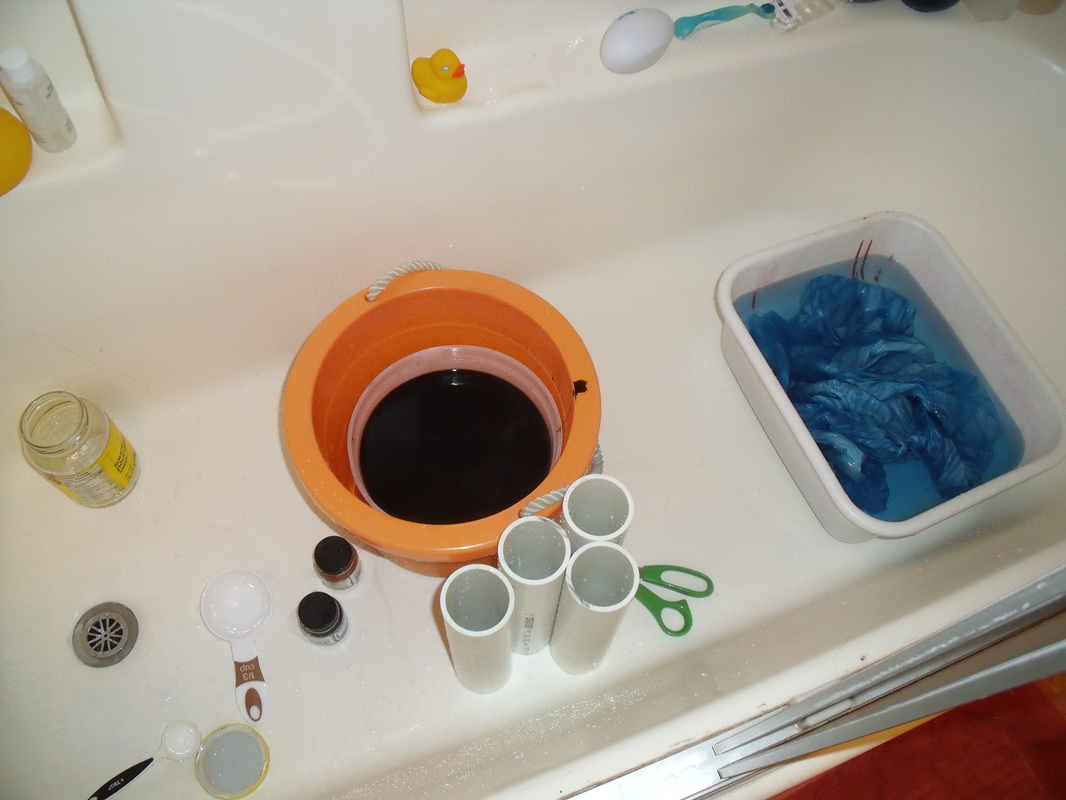
Supplies.
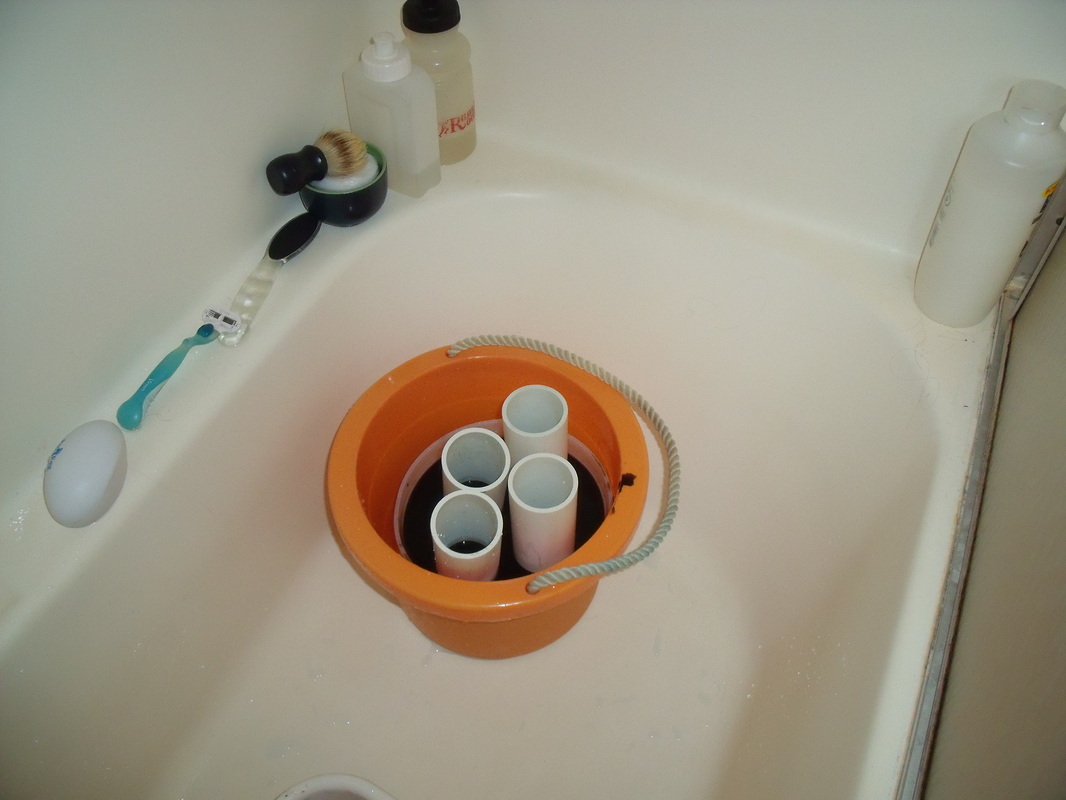
Pole-wrap in action! Most of the immersion dyeing takes place within the bathtub. I try to keep a bucket in the bathroom so that we can throw the supplies in there while we shower.
One day when I'm rich and famous I will have a separate studio outside my living quarters so that the bathroom can be for bathing and the bedrooms can be for sleeping. Or at least for less-messy crafts.
In addition to business, I have added a fair bit of exercise to my routine because I find that my quality of life is so much better if I do. I walk every day anyway, but I have also been adding running, pilates, and yoga. This ends up being between an hour to two hours of exercise a day. My back pain has disappeared, my concentration has improved, and my mood is so much better (doing something I love for a living doesn't hurt either). I don't know if I'll lose weight or develop amazing lung capacity or anything, but that would be nice too.
I am going to be volunteering with the Museum of Contemporary Craft in the Pearl District of downtown Portland. It's my favorite gallery here. I have my volunteer orientation tonight. I'm not sure how often I'll be volunteering, but it will be nice to get out more often and hang with people who love art, while supporting my favorite gallery. My other volunteer thing is that I seem to have become a chaplain with Occupy Portland. I didn't intend to do this, but like most things with the movement, it just kind of happened organically. Really, this is very nice because I got my degree in Religious Studies because I wanted to help the world, and the mainline church hasn't really needed or wanted to use my education. Here are some people who don't care that I haven't gotten my master's degree or gone through discernment committees, they just need some help. So I'm happy to be useful in that way.
Hopefully, I'll have a little more time for school soon and I can keep everyone posted on what I've learned. In the meantime, look out for more progress reports on my business projects!
Day 21 took place over a number of days, as I've been sick with a nasty cold recently and haven't always had the energy I needed to do all my work. But I chipped away at it and this is the result. The information I am presenting is not in the order that I did it, but rather the order I can keep it all straight in my head.
My warm-up was to "listen to what nature was telling me". The book even suggested that I consult a book about nature omens. Now, I don't actually believe that there is a such thing as a nature omen, so I had to make of it what I would. It did occur to me that I don't spend a lot of time just observing nature and appreciating it. The book suggested that I do a visual journal entry about it, but I didn't even know where to begin, so I decided to go out with my camera. I figure that photography can be a kind of a journal, and I am eager to improve my photography. So I went for a walk with my camera and took pictures of nature changing for fall. I particularly liked the red red leaves and the squirrels that were so happy with their acorns.
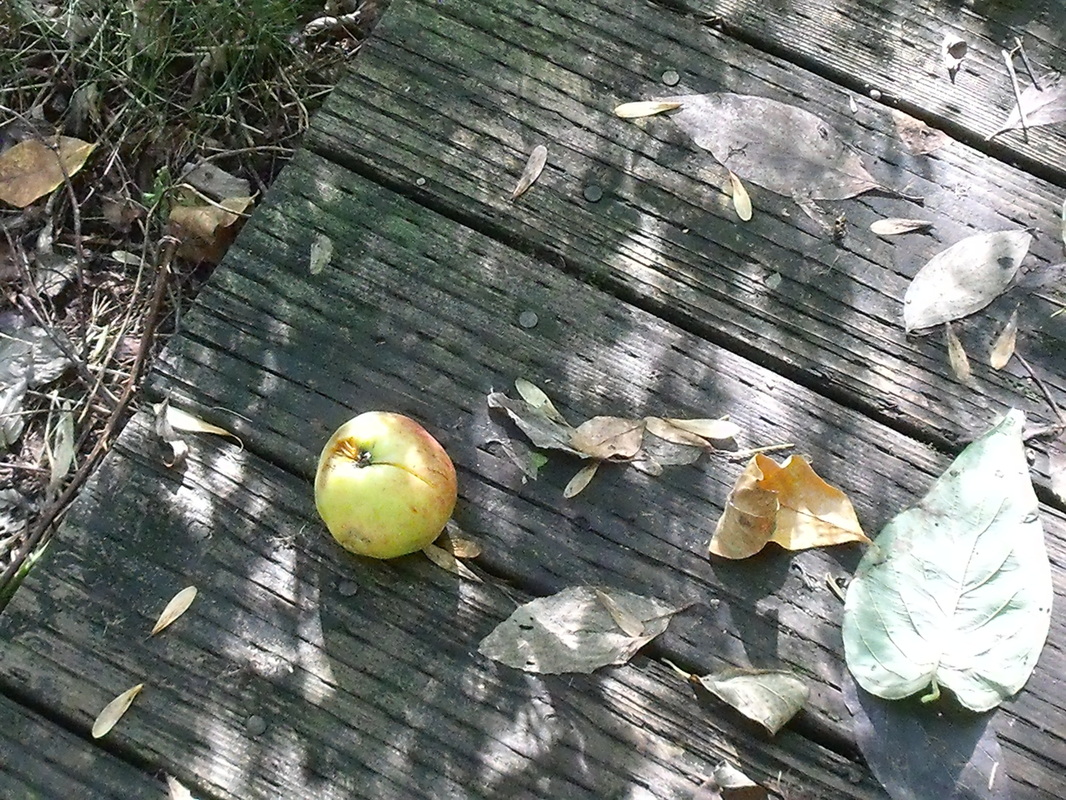
Autumn fruit.

So red!
I watched a fantastic podcast about the Jawaja leather workers of India. They were doing a presentation via Skype, with a translator. Theirs was a very inspiring story. Thirty years ago, they were so low-caste that they weren't allowed to draw water from most of the wells. The traditional way of leather working in India is to scavenge for dead cows, as you're not allowed to kill a cow. So this was a despised profession. The leather workers were very poor. Their elders decided to ban the scavenging of dead cows and work on shoes (feet are kind of taboo in India) in order to raise their status. This had the unintended effect of making it even more difficult financially for the leather workers, as they had to buy processed leather, and couldn't sell as much. Eventually, they decided that they had had enough and began to work with design schools and craft councils. They helped develop products that could be marketed overseas. They began to sell to Maiwa and made enough money that they could eat twice a day (they were eating once every two days before that) and own houses. Since the presentation, customers have been so interested in the leather work that they have had to carry extra stock. Their bags and purses are very popular and they always have a large selection on their website. I was very happy to hear about the improvement of their lives and I hope they become even more prosperous. Their social standing in the village has also improved and now they are allowed to draw from all the wells. I have been working on a drawing of crumpled paper. This is going to take me a few days., I think. It requires a lot of concentration and patience. So far, I think it looks like cloth, but we will see how it looks when I am finished. I will post pictures as I have them. I watched more podcasts on the Art of Photography. The first one I watched was about scanning negatives, and it reminded me of my first full-time job as a digital scanner. It was a good refresher, and I learned about adjusting the histogram more finely than I did at work to improve detail in the photo. The next one I watched was on dynamic range, which is the range of values in a photo. Ideally there should be a wide range of values in order to show the most detail, unless you are doing high contrast on purpose. You can adjust the values in the computer to improve the range. The next one I watched was pretty cool, on tethered shooting. This is where you set up your camera to load pictures directly onto the computer so you can tell if they are exactly as you want them (it can be hard to tell on that little screen). That way you can adjust your settings to tweak the photo. This technique is used especially for catalogue photos. The final one that I watched was on time-lapse photography. It's very interesting because you have to set your camera up to take these photos at set intervals and then not touch it. You can't adjust the lighting levels or anything or it will look strange. There are programs that you can get for your computer that will play the time-lapse and you can make a little video. In my design book, I reviewed the chapters on shape and texture. In surface design, I am proud to say that I have my bolt of cloth! I have spent the last couple of days preparing the cloth and have cut the pieces for the order for my brother. I have also been working on dyeing some other pieces that I was experimenting on, and I am washing out those pieces now. It doesn't sound like I've done a lot but preparing an entire bolt of cloth takes a long time!
Well, I'm feeling pretty sick today, so I'm taking a day off. However, I did stuff yesterday so here's my report. I started out with a podcast. It was by an artist who talked about her commissions. I am doing mostly commissions these days, so I was interested in what she had to say. She sort of built her own fiber art education, since she had studied ceramics in her undergrad and didn't have time to go back and study fibers. She did this by working in a theater costume department. She specializes in wearable art that can be worn by everyday people, not just displayed in a museum. She liked working on commission because she enjoyed the challenge of trying to meet her clients' needs while still being creative. In some cases she has even used a different medium, if fiber wouldn't be suitable. That's something I have to work on: I can do what I can do but if someone asks for something at all outside of that, I get befuddled and am unable to do it. She also had an interesting payment structure, where she collected the payment in thirds: one for the initial materials, one mid-project, and one on completion. I am not sure why you would need the mid-project collection but she said that it was what worked best for her. She also talked about how temperamental her indigo was: you have to harvest and use it at the right time or it won't work at all. One year she missed harvesting it before the frost, and the frost turned all her plants blue. She said it was stunningly beautiful and didn't seem at all disappointed that her crop was lost! Next, I did a warm-up. (Crazy, podcast before the warm-up!) The assignment was to research cultural symbols of a culture that spoke to you. I have been interested in (obsessed with) Indian culture since I was about 14 years old. Now, admittedly, most of this obsession has revolved around food. I went through my Bollywood phase and my wanting-to-wear-a-sari phase and my Ravi Shankar phase and even courted the idea of becoming Hindu for a while, but those were all things I passed through. Food has been the constant, especially vegetarian food (I am beginning to branch out into meat now). So there were actually a number of symbols that I didn't know about, or at least didn't know the importance of. I got my information here. My favorite symbols were the Deepam (a little butter lamp used for worship), the coconut, and the lotus. The Deepam is said to remove impurities, the coconut to bring prosperity, and the lotus, among other things, represents detachment (I believe that's in the Buddhist sense). I reviewed line in my design book. I looked at measure, type, direction, location, character, as well as line and shape, line and value, texture, color, spacial characteristics, and representation and expression. Learn more about line here and here. Finally, I did a drawing of a little woven box that I got some spices in. I didn't get a chance to do surface design yesterday, because the glue resist I had applied wasn't dry yet. If I can rustle up the energy to do it today, I will, but so far things aren't looking so good. I also have received a deposit to go purchase supplies for my next commission, but I think I'm too sick today to go out and get it! Hopefully I will feel better tomorrow and I can hop to it.
I sort of did this day over the span of two days. Yesterday was a holiday (Columbus Day in the US and Thanksgiving in Canada) so I only did a little work. Also, I'm having trouble with my productivity lately. I am learning stuff but not at the rate I would like. So I will see if I can ramp things up a bit over the coming week. I listened to two podcasts yesterday. The first one was about a Shibori artist from the UK. She worked primarily with Indigo, but also with iron rust. She does beautiful, intricate shibori work, which leaves me in awe. She takes quite a lot of time very carefully stitching, dipping multiple times in the dye vat, and then carefully undoing the stitching. You can see a little of her work and the kits she sells at http://www.callishibori.co.uk/. The next podcast I listened to was by a textile designer-turned cultural anthropologist who had a little money that would either let her work in her studio for six months or allow her to travel to India to study textiles. She didn't know which one she would rather do, so she flipped a coin. The coin "chose" the trip to India. She has traveled all over India, and has specialized in studying the block printers of the Kutch region in Gujarat. She specifically studied ajrakh printing. She absolutely loves traveling in India and has arranged many exhibits in the West. For business study, I watched some more of the Art of Photography episodes. The episodes I watched were all about developing film. I won't be doing that anytime soon, but it was a fascinating process to watch. The developing fluids were poured into a little light-proof case that held the film. There were three different fluids, but I can't remember what they all were. I wonder if photographers today miss this sort of process, or if they find Photoshop gives them better control. In design, I did a review of the chapter on form, doing sketches as I went. I looked at variety, balance, and dominance. It was a good review to make sure I understood the terms. I will have to give this book back to the library soon so I need to finish my review to make sure I understand all the concepts. Finally, I finished off some bookmarks, as well as a sample of a project that I am doing for my brother and sister-in-law. I worked on a few other items as well, applying the glue resist, stitching embroidery, and the tedious work of ironing everything. I find that working with cloth is half tedium and half creativity. It's a bit like cooking, where you spend half your time creating and half your time cleaning up or doing repetitive chopping or something. When I put on some music and daydream, the tedious stuff is not so bad, and I can get excited that it will lead to creative stuff. Anyways, I took some photos of my finished objects. 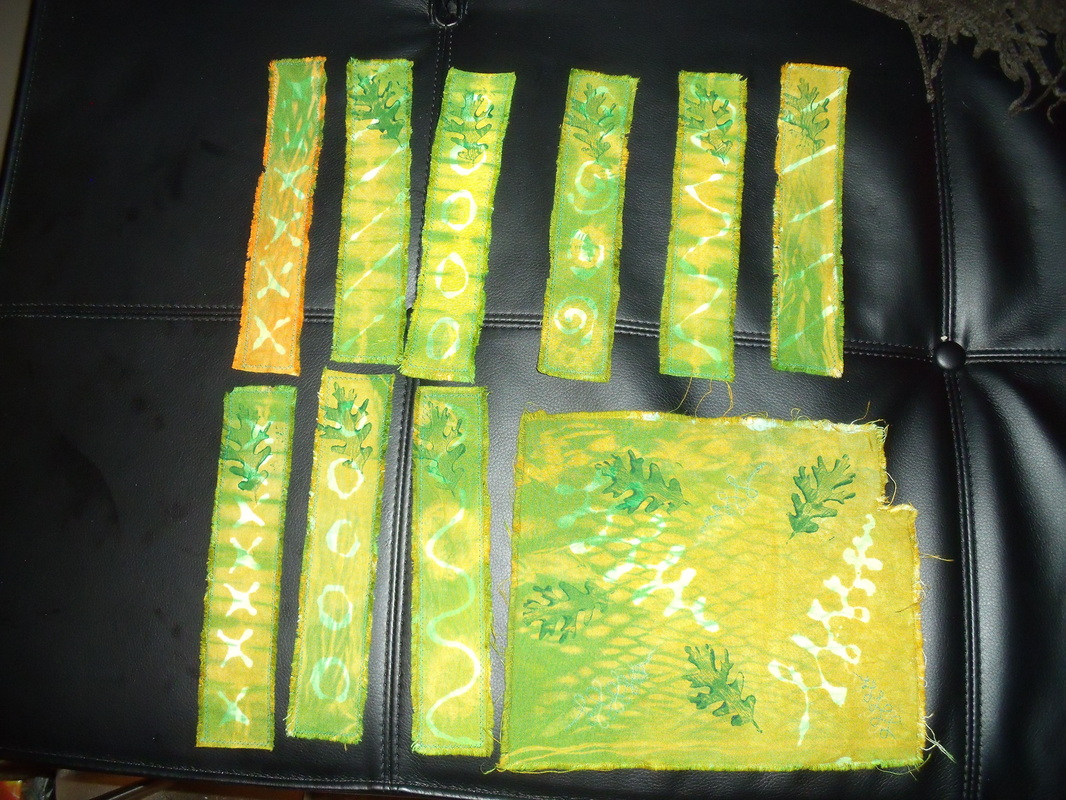 Bookmarks and sample. In the future, I will leave the leaf print off the bookmarks, as I feel that it takes away from rather than adding to the design.  Close-up of sample. Pole wrapped and dyed, glue resisted, overdyed, printed, and machine embroidered.
Today I finished listening to the roundtable discussion on the working traveler. The travelers were asked what their favorite places were to visit, and most of them had difficulty answering, because each place was so different, and a place could change so much in a matter of a few years. They also talked about how they financed their trips. It was very interesting, because none of them were rich, but they rearranged their finances so that they could travel. It was the most important thing to them, so it was their priority. They talked very little about fiber arts at this stage, but it was interesting to hear about how they managed to travel. I hope to travel more in the future (when I have finances to rearrange!) but I don't think it will be a priority for me.
I drew some shells. I am pretty happy with how they turned out. I loved all their little ridges.
I worked on rinsing out my brown dyes from yesterday. I haven't finished rinsing them yet so I'm not sure how they've turned out. I also worked on painting with some orange dye, and doing a pole wrap and a tie-dye with the leftover dyes. I don't have pictures yet but I will post them as soon as I have them.
Short post today! Hope you enjoyed!
Yesterday, I had a great experience with my friend Amber. We sort of had a skills-exchange party. Amber showed me some things about sewing and I showed her some things about knitting. We had a great day. I made a pillowcase, which doesn't actually fit any of our pillows. I know how to do it now though. Not difficult at all. From soup to nuts I think it took me under an hour. We also worked on a skirt (just the muslin, I don't intend to wear it). Anyways, I had such problems with the pattern and the book that I think I am going to quit this one and make something else instead. I have another book that the pillow pattern comes from, which might be a better fit for me. Also, Amber left some patterns for me to try, so I'm going to give those a whirl. I hope we can have another skills exchange party again soon!
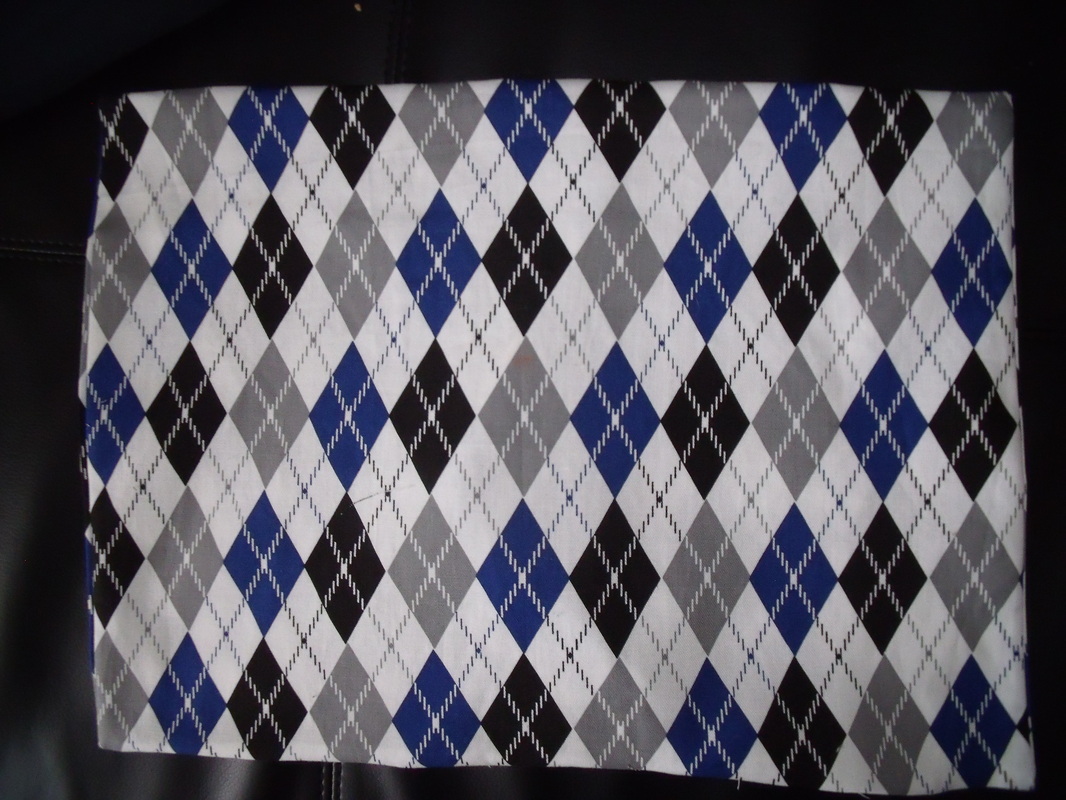
The front of my pillowcase. I like argyle.

The back, with envelope opening showing. That's how you get the pillow in.
For my business study today, I watched four more episodes on The Art of Photography. The first episode was on filters, which are more appropriate for film cameras than digital. With digital, it is more effective to use Photoshop than a filter. The second episode was on metering without a light meter, which involved changing the aperture and the f-stop. I also learned that lots of photographers take slightly darker and lighter photos to make sure that at least one turns out as they had hoped. The third was on a photographer who put together a book called The Americans, and had sort of a photojournalistic style. Finally, the last one was about composition, and there were many elements to it other than the rule of thirds. One thing that stood out was the use of triangles, often creating points with eyes. Most of these triangles were right-angle triangles. Another think I liked was the use of curves in photos, usually on one of the stress points created by the thirds. I finished the last chapter in my design book, and will be going back to invent exercises for each chapter to make sure that I have grasped the concepts. This last chapter was on time and motion. It was a pretty short pattern. Motions on the picture frame are intended to slow down the gaze of the viewer, who will usually try to look at something quickly. Motion can be implied by line direction or shape position. The sequencing of images gave rise to animation and moving pictures. Some artists, such as the Cubists, tried to give the impression of moving around the subject by showing multiple viewpoints. This can be seen in Cezanne's works, where parts of the table don't line up and where some objects are viewed head-on and others are viewed from above. Sometimes images are superimposed or blurred to give the impression of moving around the subject or to suggest motion. Think of cartoons in which the character runs, and his feet turn into multiple feet moving very quickly. The chapter has a short history of moving pictures, which I won't get into here, and also discusses video artists. Additionally, computers and multimedia can be used in art now. Motion can also be implied in three dimensional work, again by showing multiple viewpoints. Additionally, there is kinetic art, which is usually sculpture that actually moves. In dyeing today, I had an interesting experiment: trying to make brown. Theoretically, brown should be dark orange. I don't have black to add to orange (which I can make with red and yellow). What I did was to mix up some golden yellow, which is close to orange, and added a tiny bit of blue and a tinier bit of red. The dye looked pretty brown but it seemed a bit on the orange side when I painted it on. I won't know exactly what the color will be until I've washed out the dye. I am hoping it will be brown, but I can keep mixing if not. I didn't saturate my cloth with dye so I'm hoping I can dye it once more if it's not brown enough.
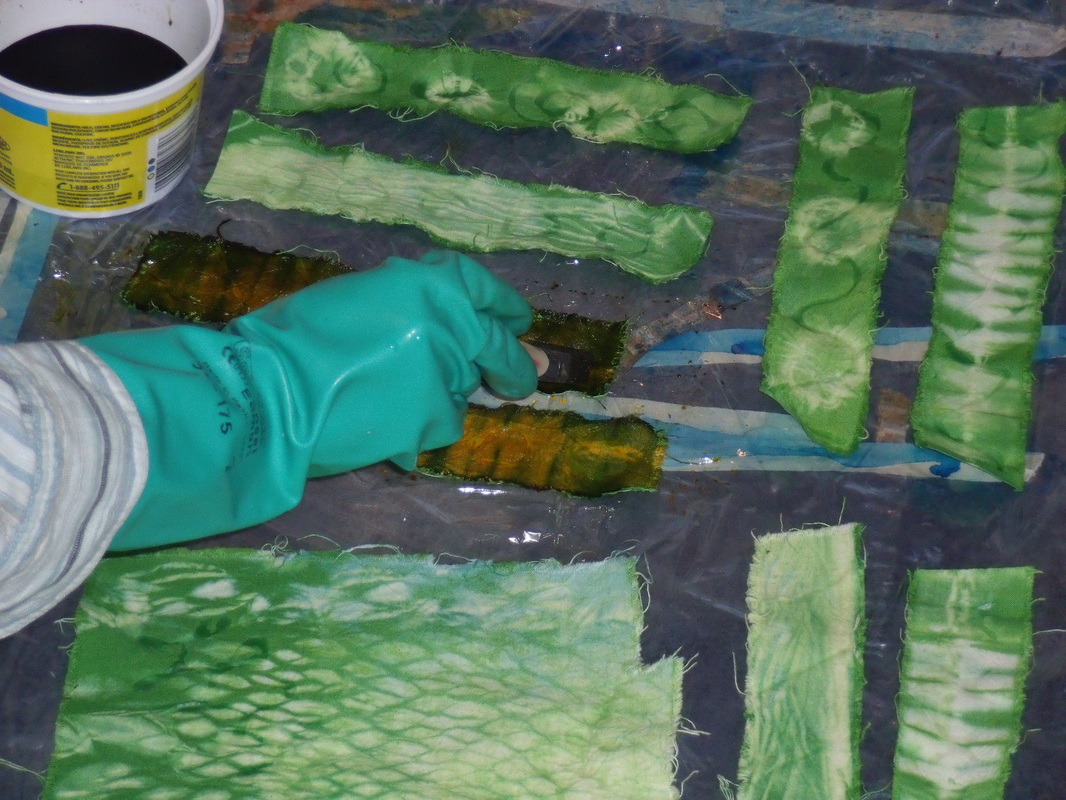
The bottom one turned out very orange. I tweaked it a bit after that.
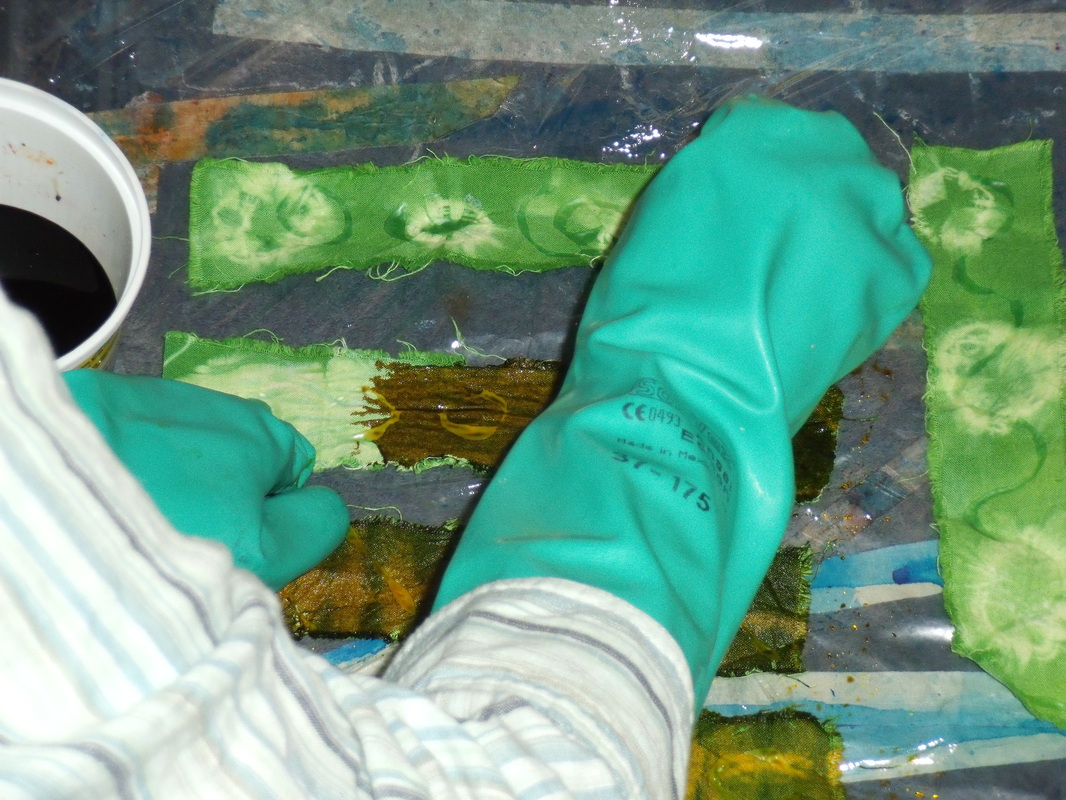
Looking browner, but still a bit orangey on the resist. We will see.
Today, I started with a warm-up to research an artist's life. The artist suggested was Frida Kahlo, which suited me fine. I'm not a Frida Kahlo fanatic, but I do like her work. Anyway, I discovered that the movie pretty much told it like it was. There were a few things in there that I didn't believe, like that she had an affair with Trotsky. Well, at least according to Wikipedia (how academically rigorous, I know) it's all true. She really was bisexual and her husband, Diego Rivera, really did have an affair with her sister. She wore long skirts because she had polio when she was a child and it deformed one of her legs. The bus accident she experienced as a teenager caused her pain throughout her life and she was frequently bedridden because of it. She became an artist after the accident (she was self-taught) and painted until her death, at age 47.
I listened to the next part of the roundtable discussion that I have been listening to lately. It was a response to audience questions, and there wasn't too much pertaining to fiber art, but more to do with traveling. They had some real horror stories about some of their travels! But there were a few important nuggets to learn, such as that unprocessed fiber isn't allowed through customs in the United States (good to know, in case I visit some sheep farms) and that there are in the world warehouses full of exquisite embroidered and woven textiles that get cut up for use in patchwork that is sold to westerners. Also, there was a plea for people to buy fewer clothes and make sure the clothes that they do buy are fair trade and, if cotton, organic, and made of natural fibers, because there is such waste in the world of textiles. This jives with my own thoughts about how people treat clothing. Some people throw clothing out. Did you know it can be reused, even if it's not wearable anymore? Old clothes are used for rags, new garments, patchwork, quilting, and rugmaking. Often clothing can be saved with a patch or some darning or a good stain remover. So think about that next time you are tempted to throw clothing away!
I drew a vase. Not much to say about it. My drawing was a little better than last time. I wonder how much of that is because of the practice of the last one and how much it was because my ceramic was matte instead of shiny. My vase sides are getting more even. Those of you who do not draw or paint, you don't know how difficult it is to get even sides on vases and bottles. Even arches are difficult. Usually they come out lopsided. This one is considerably less lopsided than my usual vase drawings, so I am happy about that.
Yesterday, I washed out all my cloths. I discovered a new technique to getting the dye out without bending over it for an hour: let it soak in several changes of hot water, for about half an hour or so at a time. It worked wonderfully and I was a lot less cranky than I usually am with the process. Today I ironed them and added a glue resist to most of them. I am working on a sample for my brother and sister-in-law as well as some bookmarks. I prepared some more bookmarks for dyeing, but I didn't have enough to bother with making up some dye today. You have to use all the dye in the same session that you make it, or it won't work, so it's not worth it unless you are actually going to use it all. I would only need about a quarter of a recipe, which is too fiddly to bother with. When the resists are dry on the rest of them I will dye them all together.  First-batch dyed cloth with school glue resists setting. The two blue ones in the corner have already had glue resists washed out of them.  Close-up on bookmarks. From left to right, they have been tie dyed (first two), pleated, pole wrapped, pleated (next two) and pole wrapped again. 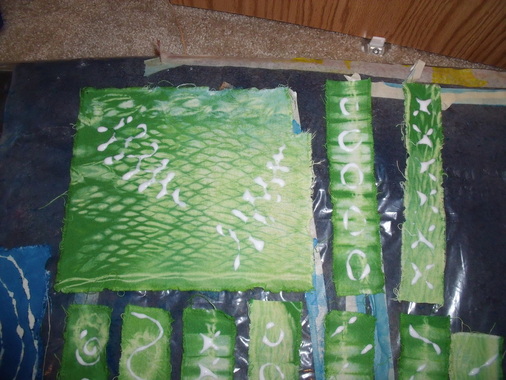 Sample and two more bookmarks. From left to right, pole wrapped, pleated, and pole wrapped again. I also designed this stamp to block print with. I modeled it on an oak leaf.  Sketch for the stamp. Oak leaves are pretty easy to draw, at least they are if you are doing a contour drawing like this.
Started a bit late this morning, but got everything done that I wanted to do. For business study, I watched more podcasts from the Art of Photography. The first one was on handheld light metering. I don't have a light meter but I can see that it might be a good investment in the future. A light meter helps you decide how to arrange your aperture and shutter speed. My camera has a built-in light meter in it, as probably does yours. When this is the case, the camera "decides" automatically on the shutter speed and aperture. Again, that's not something I have control over in my point-and-shoot but it is something to be aware of. The other two podcasts I watched were about lenses. All cameras have lenses, and most actually have more than one inside. On an SLR you can change the lenses to suit your needs. My camera doesn't have this option, but it does have settings that simulate different lenses. I don't know if these have problems with distortion or not, but I expect they would because all lenses cause some type of distortion. The trick is to get the distortion you want for your particular photo. These podcasts make me really want an SLR! But that is not an option at the moment and I can live with what I have. I haven't always been lucky enough to have any camera at all, so I can't really complain. In my design book, I studied space. I actually started studying the chapter a couple of days ago but didn't finish it until now. There is a lot of wordiness that I didn't understand in this chapter, but I understood as soon as I saw the picture illustrating it. Unfortunately, I can't show you the pictures from the book, so my words will have to do. There are two major types of space in two-dimensional art: decorative space (flat-looking surface) and plastic space (looks like it has depth). Plastic space is further divided by shallow space and deep or infinite space. Shallow space looks like the picture has some depth, but not very much. The artist might have manipulated some tricks to make the image look flat. Deep space looks like how we would actually see something in the real world (again, the artist uses tricks to make us think that it is as we would see it) and infinite space is just what it sounds like. There are spacial indicators. Sharp detail looks close to us, and diminishing detail looks far away. Larger items appear closer than smaller items. The position of a shape can make it appear closer: the horizon line is usually at eye level, so shapes below that on the canvas appear closer than shapes above it. If an item is overlapping another item, it appears closer. Transparency can be used with overlapping items to make them appear closer. Interpenetration is when planes or objects pass through each other, and depending on what is pictured, can create shallow or deep space. Fractional representation, which is seen in ancient Egyptian art, is when we picture a subject using those parts that best represent it in our heads. For example, in Egyptian paintings the head is a side view while the eye is full on, the torso faces forward but the hips and legs face the side. Converging parallels is when two sides of an object, which we know to be parallel, have sight lines pointing toward the same vanishing point. Linear perspective is a way of representing sizes and distances of objects in space. There are three major types of linear perspective: one-point, two-point, and three-point. One-point perspective has a single vanishing point in the picture, and was used frequently in Renaissance art. Two-point perspective has two vanishing points, usually located off the canvas. A view of a city might be a good example of two-point perspective. Three-point perspective is used when an exaggerated view is pictured. This can either be bird's-eye view or worm's-eye view. There are formulas for making sure that shapes in the picture will be spaced in a way that seems to suggest distance to our eyes, which I won't get into because there are so many of them. There are some disadvantages to linear perspective: it does not actually show things as we see them, you can only see things from one position in space, it can be monotonous, and the items pictured are distorted. There are other projection systems as well. Oblique projection does not have vanishing points, but does show a the side as well as the front of a shape, with the side at a 45 degree angle. It is used by engineers and architects. Isometric projection shows two sides of the object, both at 30 degree angles, as well as the top. Again, there are no vanishing points. It is used by drafters. Orthographic drawing, all objects are drawn perpendicular to a base line. It is used in engineering and industrial settings. Reverse perspective is seen in traditional East Asian art, in which the back of objects are wider than the front of them. Intuitive space is the creation of space without rules or guidelines. Lines can create space, appearing to recede or advance. Shapes can create space through overlapping. Value can create space as well: usually the lighter something is, the closer it appears, and the darker it is, the further away it seems, although this can be reversed. Texture can influence space: sharp, clear, and bold indicate closeness, and fuzzy, dull, and small textures usually suggest distance. Color can also indicate space: analogous colors create limited space, while contrasting colors create a lot of space. There is a way to create space called structured ambiguity, in which the shapes in the foreground and background seem to switch depending on what colors are around it. For this reason, beginning artists are usually encouraged not to frame their work with a black mat. Space is also crucial in three-dimensional work. Sculptures could be flat, or they could have open voids. They can be spaced apart enough that the viewer has to walk around or through them. Instillations are works that the viewer has to walk through to experience, and they use space as part of the art. I worked some more on my commissions and items for my online store. I had a lot of fairly boring work to do, involving prepping the fabric. However, I did get to do a bit of dyeing, all immersion this time. I am doing some pole-wrapped bookmarks and some tie-dyed ones. I also did a pole-wrap of a sample for the commission I am doing for my brother and his wife. They want green and brown natural-looking placemats and napkins, but they wanted to see a sample first. Fair enough: this gives me a chance to work out any kinks (like, how do I make brown?) before I start working on their actual project. I also washed out a cloth I dyed yesterday, using pleating, but it currently looks so unimpressive that I didn't bother to take a photo. I will use it to figure out how to create layers when the background color is dark.
I am back in Portland for the time being, so I have access to all my stuff here. It's really nice to be around my supplies and my husband again. I had a grueling time getting back--what was supposed to be an eight hour trip (by land) became 15 1/2 hours. I spent the next couple of days recovering from that. But I am back in the swing of things now. We have decided that I will spend half my working day in study, and half in production and business. I am also happy to announce that I have made my first large sum of money! This was on the commission I had told you about earlier, for my friend Melanie. Here are the pictures of my work:  Long view. It's a table runner. 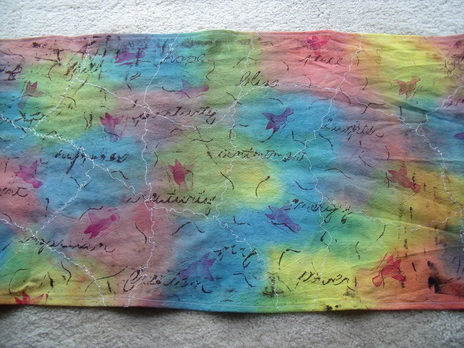 The middle. 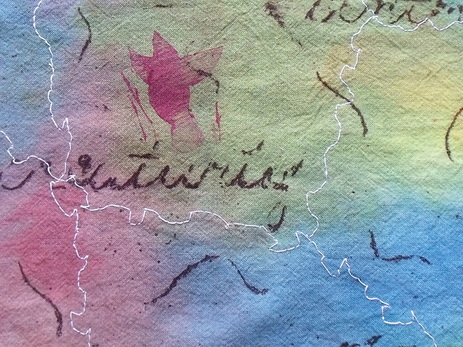 Detail. The table runner was made with a number of steps. First, I had to wash the fabric with a special soap to get all the oils and imperfections out (it was sort of a natural beige when I started). Next, I painted the fabric with liquid dye. I let it rest a couple of days and then rinsed the excess dye out (this process usually takes me about an hour). Then, I pinned the cloth to my work surface and put a flour paste over top. I wrote words and squiggles in the paste with a skewer. I let that dry for a few days and squished the hardened surface to make it crackle. I then applied a thickened dark purple dye over top with a brush, really working the dye into the cracks. After another couple of days I soaked it in warm water to remove the flour paste, and then washed it to remove the excess dye. I had to do this flour paste and dye step four times because my work surface was only so big. Next I carved out a bird stamp with safety cut lino, and used that to print the birds with textile paint. After that dried and 24 hours had passed, I heat set it with an iron. Then I sewed the white stitching on with my sewing machine and a free-motion darning foot. It took me quite a while because I spent as much time unjamming my machine as I did sewing! Then I pulled and pulled on the fabric to straighten it out (it bunched a bit when I embroidered it) and ironed it to make it flatter. Finally, I sewed all the edges so they wouldn't fray. And that, my friends, is what goes into my work! Today I started with a little warm-up. It was very similar to a warm up I had done before, in which I thought about my artistic "DNA" and why I was attracted to surface design in particular. I'm still not sure I can explain--I understand why I am into fiber arts (my mother did it, her mother did it, her mother did it, etc.) but when I tried surface design, it just felt right. It felt like what I was supposed to be doing. I can't really explain it any other way. Next, I listened to two podcast. I had heard them both before. The first one was the second part of the round-table discussion I was listening to earlier. I listened to it on the train originally but I had such an awful day that I forgot it all. It was actually still difficult to remember, because people were mostly talking about what they felt like talking about rather than having an organized topic. There was some discussion on the commercialization of textile traditions, whether it be that a peasant ask for money to be photographed in her traditional costume, or from outside companies who market a traditional craft for a little while until it ceases to be trendy. They talked a bit about going to remote locations to find crafts, and the excitement and danger that could be involved. They talked about the tragedy of collectors buying up all the crafts in one area until there were none left and no one knew how to make them anymore, and how the public sometimes doesn't understand the textiles that they are viewing. One of the panelists had to sell most of her collection of textiles in an auction because she didn't have the space to store them anymore, and not one of the people who bought the work has contacted her to find out about her research on that particular textile. She also collected many pieces for the Victoria and Albert Museum, and by the time she was finished, they were no longer interested. There have, however, been some interest by the national archives, so that is positive. The other podcast I listened to was about a clothing company called Ocelot. I had heard this podcast before but the website had pictures to go with it so I listened again. The podcast explained how the artist got into dyeing and making clothing: she was exposed to dyeing as a child, and got into costume design after college. Eventually, she became fascinated with natural dyeing and clothing construction, and seeks to create clothing that is timeless and beautiful. In her dyeing, she uses wooden blocks as physical resists. You should really check out her work because it's absolutely beautiful. Then, I drew. I drew a bowl. It was a white bowl, but that doesn't really show from the shading I did. Need to work on that shading. I was quite successful with shading in my last drawing, but it was much more difficult to depict a smooth surface. I will have to draw more white ceramic. For surface design, I am trying a glue resist with dye. It worked very well with fabric paint and now I will see how well it works for dye. I also learned how to get dye out of the carpet! Dropcloth it is then. I had loads of leftover dye so I painted dye on one piece of cloth and tried a pleated resist with another. Those will take a day or two to do their thing, so I don't know how they will all turn out yet.
My husband did some research on my behalf to investigate how to reach Canadian customers. I am focusing on Canadians right now due to my immigration status. I don't want to say too much about it, but it is possible that there may be some disruptions in the next few months, which would affect my unschooling and my business. But we don't know for sure yet. My husband also contacted customers for me and arranged deposits and such. I am very excited to have him as my business partner. He is much better at promoting me than I am, and at settling deals!
For production today, I had the rather boring task of cutting out and scouring fabric for bookmarks. I am hoping to make bookmarks an affordable way for people to buy my art. Most of my stuff isn't cheap, and I have friends who don't have a lot of money who would like to partake. I thought this would be a good way, since I can't lower my prices. I just pay myself a little over minimum wage, so I don't listen to any complaints about the prices being too high!
That's it for the day. I'm off to eat dinner and meditate.
I suppose the way to hell is paved with good intentions, and I had the best intentions to study while on my trip. Perhaps not surprisingly, it didn't work out that great. But at least I have done some studying. I listened to a podcast that was the first part of a roundtable discussion of prominent people in the worldwide fiber arts field. There was a woman who was an expert on fibers and the animals who supplied them; another who was the expert on worldwide embroidery; one who had a weaving cooperative; one who ran the store and foundation that supplied these podcasts, as well as doing a million other things to support traditional fiber artists in India; and another fellow whose area of expertise escapes me at the moment. They talked about what it was like to be working travellers: none of them traveled for enjoyment, particularly, or to take a vacation. They all traveled for their work. They were all trying to figure out how to balance intervention in the craft making process. For those who sold traditional work, they tended to encourage people to do the work native to their area, in a high-quality manner. Without these kinds of controls, some craftspeople might do low quality work to sell the craft, leading to its devaluation and the eroding of the skills necessary to produce it. Other craftspeople might be contracted to do work that is not traditional to that region, again leading to the erosion of skill, but also exposing people to the vicissitudes of the worldwide market (that is, if Indian embroiderers are doing Danish style embroidery, and Danish style embroidery goes out of fashion, they will lose their livelihoods. If they do the work that is native to their region, they will always appeal to collectors and those interested in quality regional work.) Some of the panelists were interested in keeping work exactly as it was, never changing. There woman who studied embroidery was dismayed because there was a certain area in India where young women would embroider elaborate pieces for their dowries. Now they embroider pillows for sale. The gentleman whose profession I can't remember pointed out that he had been criticized in India for wanting to "play God", or tell people what they could or could not produce. In the example of the dowry work, he said that many girls no longer bring dowries to the marriage, and if they have such incredible embroidery skills they don't want to use them on something that only their families will see, but on something they could make money on. If they made that money, they could spend it on their children's education and health care for the family and better food. All the presenters said that they don't like interfering, but when crafts are being produced for markets sometimes they have to enforce quality control. Sometimes, these businesses keep the crafts from dying out completely, as the children of many artisans want to be professionals instead. In my design book, I studied the chapter on color. It was a long and technical chapter and I had a lot of trouble with it. It will be difficult to transfer the information to dyes, as dyes have different properties than pigment or light. We see color because of how light reflects off of objects. Colored light is referred to as additive color. The primary additive colors are red, blue (which is close to violet) and green. Combined, they create the additive secondaries of cyan, magenta, and yellow, and when all colors are combined together, they make white. TVs and computers use additive color. Subtractive color is that which comes from pigments. It is called subtractive because pigments absorb some colors from sunlight and reflect others. For example, a green leaf reflects green and absorbs all other colors. There are color systems that drove me crazy. In the triadic color system, the primary colors are yellow, red, and blue. The secondary colors are orange, green, and violet (each one of these sets is a triad) Then there are intermediate colors: red-orange, yellow-orange, yellow-green, blue-green, blue-violet, and red-violet. An intermediate triad would either be yellow-orange, blue-green, and red-violet, or red-orange, yellow-green, and blue-violet. When all these colors are put in order in a circle, they form the 12-point color wheel ( go play with the palette at the bottom of this page). The colors directly opposite each other on the color wheel are known as complimentary colors. For example, the complimentary color of red is green. When a color is mixed with its complement, it grays and creates what is known as a tertiary color. For example, green mixed with a little red creates olive. Tertiary colors can also be created by mixing any two intermediate colors, so long as they are not next to each other on the color wheel (analogous colors). They are found on the inner ring of the color wheel. In the center of the color wheel is complete neutralization, which is a muddy grey. There are also neutrals, not on the color wheel. These are black, which is the absence of color, white, which is all colors, and grays, which are impure whites. Hue refers to the generic color name of the color, i.e. red, blue, green, etc. Colors vary in value, with the highest value color (yellow) at the top of the color wheel and the lowest value (violet) at the bottom. It is difficult to see the relative values just by looking at a picture, and it helps to photocopy the picture in black and white to be able to see the values. You can also lighten or darken hues. By adding white to a hue, you create a tint, and when adding black, you create a shade. Intensity refers to the brightness of a color. A bright red and a grayed red are the same hue, but the bright red has greater intensity. You can also increase the appearance of intensity by putting a color with it's complement, like green with red (maybe that's why Christmastime is so colorful?) Color relationships drove me a bit crazy too. There are complements (opposite on the color wheel), split complements (immediately on either side of the opposite color on the color wheel), triads, which we talked about previously, tetrads, which form a square or a rectangle on the color wheel (for example orange, yellow-green, blue, and red-violet), analogous, which are all the colors next to each other in a small range on the color wheel (say yellow to blue-green), monochromatic colors, which are the same hue but different values, warm colors (reds, oranges, yellows), cool colors (blues, greens, violets), plastic colors (red pops out on a page, blue recedes), simultaneous contrast (colors placed next to each other that make them look different), the emotional impact of color, and psychological impacts of color (i.e. red for anger, green for calm, etc). Color can be used in composition to create contrasts and depth, create mood and emotions, attract attention to something, describe objects, and create aesthetic appeal. In color balance, artists have to find an appropriate balance between harmony and contrast. There is more material in this chapter but I won't go into it, partly because it's about how printing works and I don't think that's applicable to me, and partly because I've been blogging for more than an hour and I'm getting tired! For business study, I read some entries from the Etsy blogs about how to make a living at Etsy. They emphasized good photos (something I have to work on), many product descriptions, and a good shop name. My previous shop name, Penthisilea, isn't great because it's hard to spell (it's actually spelled wrong in my shop) and if you don't know the legend, hard to remember. So I will be choosing a new shop name for my products. Also, banners are important, and you can hire an Etsy seller who does banners to create a better banner for you. They also remind you that photography, site maintenance, and packaging all take time, and this time should be accounted for in the cost of the item. Many people make their living off of Etsy (some even make six figure salaries) so good products and working at it appropriately, I should be able to make my living at it too. No drawing to report for today. Good night!
|






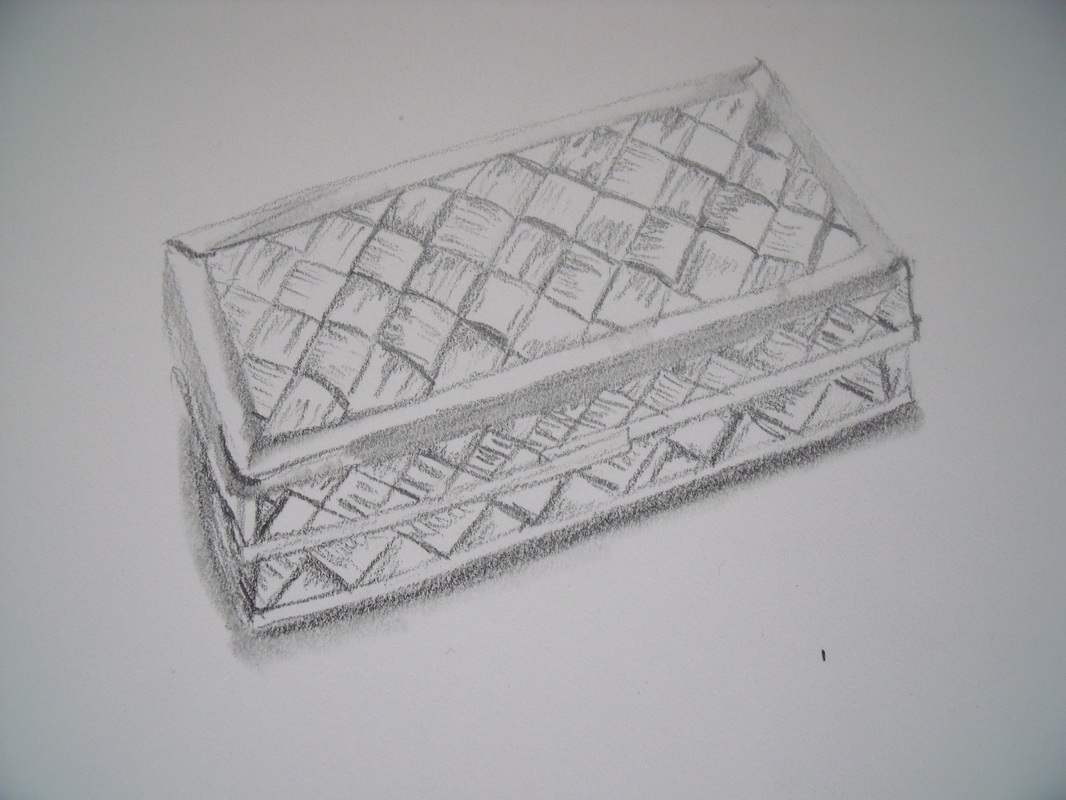


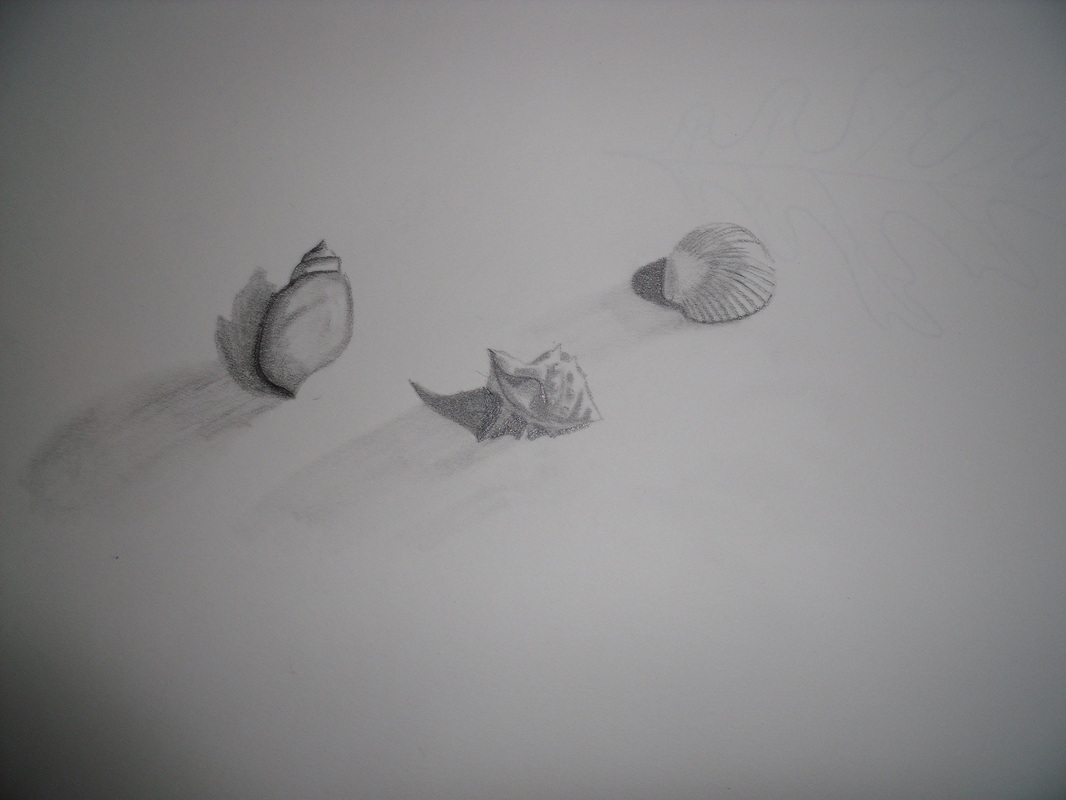




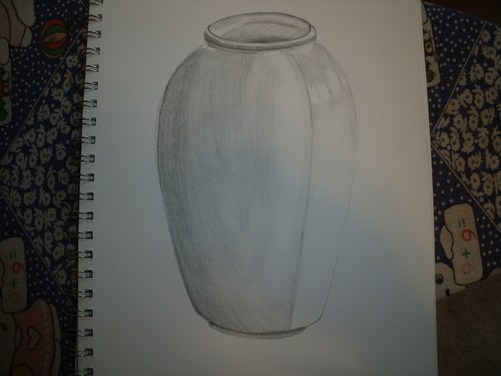









 RSS Feed
RSS Feed
